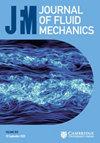Molecular kinetic modelling of non-equilibrium evaporative flows
IF 3.9
2区 工程技术
Q1 MECHANICS
引用次数: 0
Abstract
Recent years have seen the emergence of new technologies that exploit nanoscale evaporation, ranging from nanoporous membranes for distillation to evaporative cooling in electronics. Despite the increasing depth of fundamental knowledge, there is still a lack of simulation tools capable of capturing the underlying non-equilibrium liquid–vapour phase changes that are critical to these and other such technologies. This work presents a molecular kinetic theory model capable of describing the entire flow field, i.e. the liquid and vapour phases and their interface, while striking a balance between accuracy and computational efficiency. In particular, unlike previous kinetic models based on the isothermal assumption, the proposed model can capture the temperature variations that occur during the evaporation process, yet does not require the computational resources of more complicated mean-field kinetic approaches. We assess the present kinetic model in three test cases: liquid–vapour equilibrium, evaporation into near-vacuum condition, and evaporation into vapour. The results agree well with benchmark solutions, while reducing the simulation time by almost two orders of magnitude on average in the cases studied. The results therefore suggest that this work is a stepping stone towards the development of an accurate and efficient computational approach to optimising the next generation of nanotechnologies based on nanoscale evaporation.非平衡蒸发流的分子动力学建模
近年来,利用纳米级蒸发的新技术不断涌现,从用于蒸馏的纳米多孔膜到电子器件中的蒸发冷却,不一而足。尽管基础知识越来越深入,但仍然缺乏能够捕捉对这些技术和其他此类技术至关重要的基本非平衡液-气相变化的模拟工具。本研究提出的分子动力学理论模型能够描述整个流场,即液相和汽相及其界面,同时在准确性和计算效率之间取得平衡。特别是,与以往基于等温假设的动力学模型不同,所提出的模型可以捕捉到蒸发过程中出现的温度变化,而且不需要更复杂的平均场动力学方法的计算资源。我们在三个测试案例中对本动力学模型进行了评估:液汽平衡、近真空条件下的蒸发和蒸汽蒸发。结果与基准解决方案非常吻合,同时在所研究的案例中,模拟时间平均缩短了近两个数量级。因此,研究结果表明,这项工作为开发精确高效的计算方法、优化基于纳米尺度蒸发的下一代纳米技术奠定了基础。
本文章由计算机程序翻译,如有差异,请以英文原文为准。
求助全文
约1分钟内获得全文
求助全文
来源期刊
CiteScore
6.50
自引率
27.00%
发文量
945
审稿时长
5.1 months
期刊介绍:
Journal of Fluid Mechanics is the leading international journal in the field and is essential reading for all those concerned with developments in fluid mechanics. It publishes authoritative articles covering theoretical, computational and experimental investigations of all aspects of the mechanics of fluids. Each issue contains papers on both the fundamental aspects of fluid mechanics, and their applications to other fields such as aeronautics, astrophysics, biology, chemical and mechanical engineering, hydraulics, meteorology, oceanography, geology, acoustics and combustion.

 求助内容:
求助内容: 应助结果提醒方式:
应助结果提醒方式:


